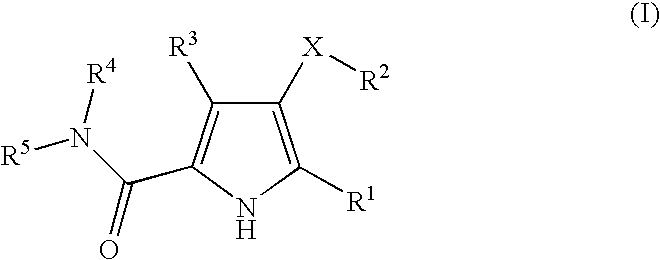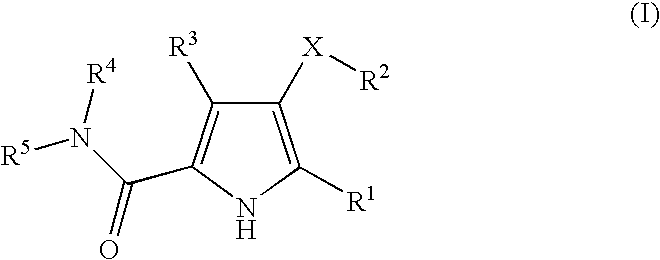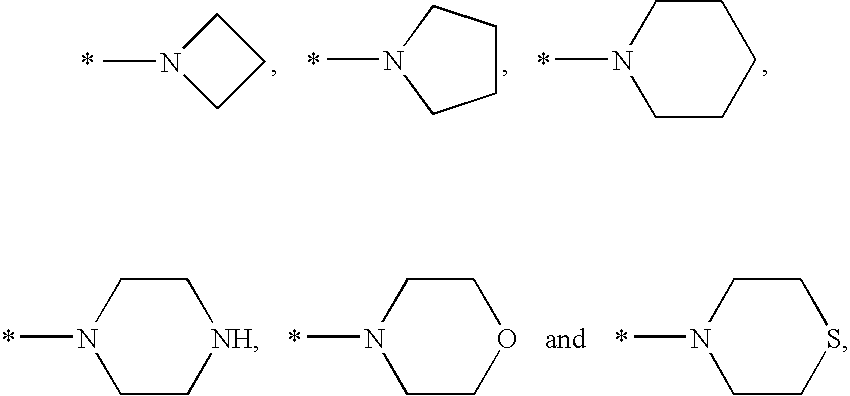Non-nucleoside reverse transcriptase inhibitors
a reverse transcriptase inhibitor and non-nucleoside technology, applied in the direction of biocide, heterocyclic compound active ingredients, drug compositions, etc., can solve the problems of mutant hiv strains that are resistant to known inhibitors, and are highly susceptible to debilitating and ultimately fatal opportunistic infections
- Summary
- Abstract
- Description
- Claims
- Application Information
AI Technical Summary
Benefits of technology
Problems solved by technology
Method used
Image
Examples
example 1
N-(2,4-Dichlorobenzyl)-N,3-dimethyl-4-(1-phenylsulfonyl)-1H-pyrrole-2,5-dicarboxamide
[0514]
Step 1: Ethyl 3,5-dimethyl-4-phenylthio-1H-pyrrole-2-carboxylate
[0515]A solution of ethyl 3,5-dimethyl-1H-pyrrole-2-carboxylate (5.00 g, 29.90 mmol) was dissolved in dry DMF (100 mL) in a 500 mL flask under nitrogen. Sodium hydride (1.43 g, 59.80 mmol, 60% dispersion in oil) was added and the reaction stirred at room temperature for 5 minutes. Benzene disulfide was added and the resulting mixture was stirred at 65° C. for 22 hours. The reaction mixture was poured into cold water (1 L), and the resulting solid was collected by filtration. The solid was suspended in hexane (500 mL), stirred for 10 minutes and then filtered. The solid was washed with hexane (100 mL) and dried to obtain the title compound.
Step 2: Ethyl 3,5-dimethyl-4-phenylsulfonyl-1H-pyrrole-2-carboxylate
[0516]A solution of ethyl 3,5-dimethyl-4-phenylthio-1H-pyrrole-2-carboxylate (1.12 g, 4.06 mmol) in chloroform was cooled to 0°...
example 2
N-(2,4-Dichlorobenzyl)-4-[(3,5-dichlorophenyl)sulfonyl]-N,3-dimethyl-1H-pyrrole-2,5-dicarboxamide
[0523]
Step 1: Ethyl 4-[(3,5-dichlorophenyl)thio]-3,5-dimethyl-1H-pyrrole-2-carboxylate
[0524]A solution of 3,5-dichlorobenzenethiol (2.14 g, 11.96 mmol) and triethylamine (5 drops) in dry dichloromethane (20 mL) was cooled to 0° C. To this mixture was added a solution of sulfuryl chloride (0.970 mL, 11.96 mmol) in dichloromethane. The reaction was stirred under nitrogen for 1 hour at room temperature. The dichloromethane was evaporated in vacuo, and the residue re-dissolved in dry dichloromethane (20 mL). This solution was added to a solution of ethyl 3,5-dimethyl-1H-pyrrole-2-carboxylate (1.00 g, 5.98 mmol) in dry dichloromethane (20 mL). The reaction was stirred for 1 hour at room temperature, and then quenched with saturated aq. sodium bicarbonate. After stirring overnight, the layers were separated and the organic phase washed with saturated brine and dried over sodium sulfate. The cr...
example 3
N-Benzyl-N,3-dimethyl-4-(3,5-dimethylphenylsulfonyl)-1H-pyrrole-2,5-dicarboxamide
[0528]
Step 1: Ethyl 4-[(3,5-dimethylphenyl)thio]-3,5-dimethyl-1H-pyrrole-2-carboxylate
[0529]The title compound was prepared from ethyl 3,5-dimethyl-1H-pyrrole-2-carboxylate according to the procedure described in Example 2, Step 1, except using 3,5-dimethylthiophenol in place of 3,5-dichlorothiophenol.
Step 2: N-benzyl-N,3-dimethyl-4-(3,5-dimethylphenylsulfonyl)-1H-pyrrole-2,5-dicarboxamide
[0530]The title compound was prepared according to the procedure described in Example 2 Steps 2-4, except using ethyl 4-[(3,5-dimethylphenyl)thio]-3,5-dimethyl-1H-pyrrole-2-carboxylate in place of ethyl 4-[(3,5-dichlorophenyl)thio]-3,5-dimethyl-1H-pyrrole-2-carboxylate, and N-methylbenzylamine in place of N-methyl 2,4-dichlorobenzylamine, and proceeding through analogous intermediates. MS (M+1) 440.1648
PUM
| Property | Measurement | Unit |
|---|---|---|
| temperature | aaaaa | aaaaa |
| temperature | aaaaa | aaaaa |
| temperature | aaaaa | aaaaa |
Abstract
Description
Claims
Application Information
 Login to View More
Login to View More - R&D
- Intellectual Property
- Life Sciences
- Materials
- Tech Scout
- Unparalleled Data Quality
- Higher Quality Content
- 60% Fewer Hallucinations
Browse by: Latest US Patents, China's latest patents, Technical Efficacy Thesaurus, Application Domain, Technology Topic, Popular Technical Reports.
© 2025 PatSnap. All rights reserved.Legal|Privacy policy|Modern Slavery Act Transparency Statement|Sitemap|About US| Contact US: help@patsnap.com



